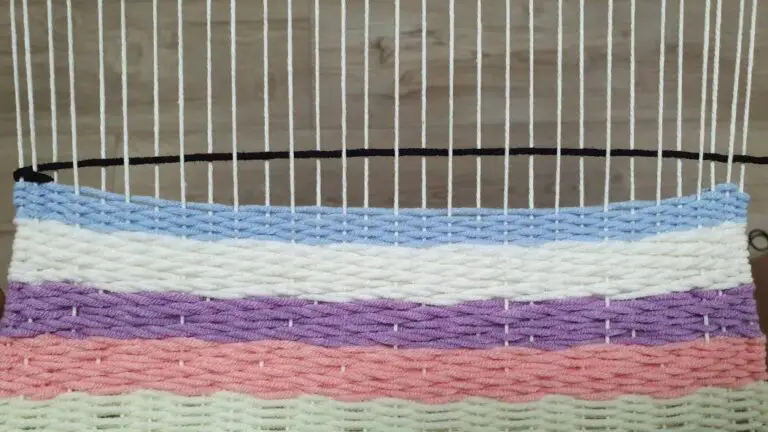8 Beautiful And Invasive Weeds With Pink Flowers (With Pictures)
Invasive weeds with pink flowers are a unique and captivating addition to any garden, but it’s crucial to be aware of the potential harm they can cause to local ecosystems. In this article, we’ll delve into eight invasive weeds featuring stunning pink blooms, exploring what makes them so problematic and how you can prevent their spread.
These pesky plants often outcompete native species for resources, disrupting delicate balances in ecosystems.
By understanding the characteristics of these invaders, you can take steps to eradicate them from your garden and protect the environment.
Let’s start by examining eight invasive weeds with pink flowers: Bindweed (Convolvulus arvensis), Dove’s Foot Cranesbill (Geranium molle), Henbit (Lamium amplexicaule), Herb Robert (Geranium robertianum), Red Clover (Trifolium pratense), Rosebay Willowherb (Epilobium angustifolium), Selfheal (Prunella vulgaris), and Spear Thistle (Cirsium vulgare).
We’ll explore what makes each plant a problem, how to identify them, and most importantly, how to remove them from your garden.
By learning about these invasive weeds, you can take proactive steps to protect the environment and maintain a healthy, thriving garden.
Bindweed (Convolvulus arvensis)
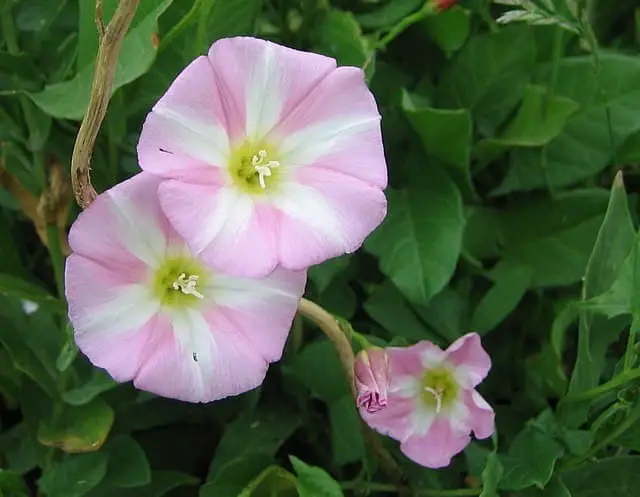
What is bindweed?
A ubiquitous weed, bindweed is a familiar sight in many gardens and agricultural fields. Its distinctive characteristic is its sprawling, thread-like stems that can reach impressive heights of up to six feet. The leaves of this plant are a lush green, while the flowers come in a range of hues, typically white or soft pink. As a member of the morning glory family, bindweed shares some commonalities with its more desirable cousin, including its ability to produce attractive, trumpet-shaped blooms.
Where does bindweed come from?
Originally hailing from Europe and Asia, bindweed was first introduced to North America in the early 17th century. Since then, it has thrived across the continent, establishing itself as a naturalized part of the region’s flora.
What does bindweed look like?
Bindweed, a perennial herbaceous plant, can grow quite tall, reaching lengths of up to two meters. Its slender stems are uniquely adapted for twining, accompanied by small, distinctive arrowhead-shaped leaves. During the summer months, the plant produces white or pink flowers that add a touch of color to its surroundings.
Why is bindweed a problem?
Bindweed’s notorious reputation stems from its tendency to swiftly overtake areas once it takes hold. This invasive species is notoriously challenging to manage, as it can quickly outcompete native vegetation, leaving little room for other flora to thrive. As a result, farmers and gardeners alike often find themselves at the mercy of bindweed’s relentless spread.
How to get rid of bindweed:
For effective bindweed eradication, consider uprooting the invasive species by grasping its roots and pulling gently but firmly. Be aware that this approach can be challenging due to the plant’s extensive root network. As an alternative to chemical control methods, you may want to attempt smothering the unwanted vegetation with a layer of black plastic or cardboard. This technique deprives the bindweed of essential sunlight, hindering its growth and development.
Dove’s Foot Cranesbill (Geranium molle)

What is a dove’s foot cranesbill?
Dove’s foot cranesbill, a member of the geranium family, derives its unique name from the distinctive dove-shaped leaves that characterize this species. Native to Europe and Asia, the plant has been inadvertently introduced to North America, where it is now classified as an invasive species. Characterized by its compact growth habit, Dove’s foot cranesbill typically reaches a modest height of 15 centimeters (0.59 inches).
The leaves are covered in fine hairs, while the flowers display a range of colors, including pink, white, and purple. These blooms unfold from May to September, painting the landscape with vibrant hues during this period.
What does dove’s foot cranesbill look like?
Dove’s foot cranesbill is a diminutive yet striking plant, characterized by its pale pink blooms. Its leaves are intricately divided into long, slender segments, imparting a fern-like quality. The flower clusters are situated at the tips of the stems, each featuring five delicate petals. Interestingly, the plant owes its common name to the dove-shaped pattern that can be seen in its foot-like structure.
How to get rid of dove’s foot cranesbill:
To eradicate dove’s foot cranesbill, a comprehensive approach is essential. Firstly, you’ll need to uproot the plant and its extensive root system. A manual removal by hand or with the aid of a shovel can be effective. However, if the infestation is more substantial, utilizing a weed whacker or lawn mower to initially cut the plant down to size may be necessary. Once the unwanted vegetation has been removed, it’s crucial to dispose of it properly to prevent further spread.
As an alternative, herbicides can be employed to guarantee complete eradication, although this may not always be required.
Henbit (Lamium amplexicaule)
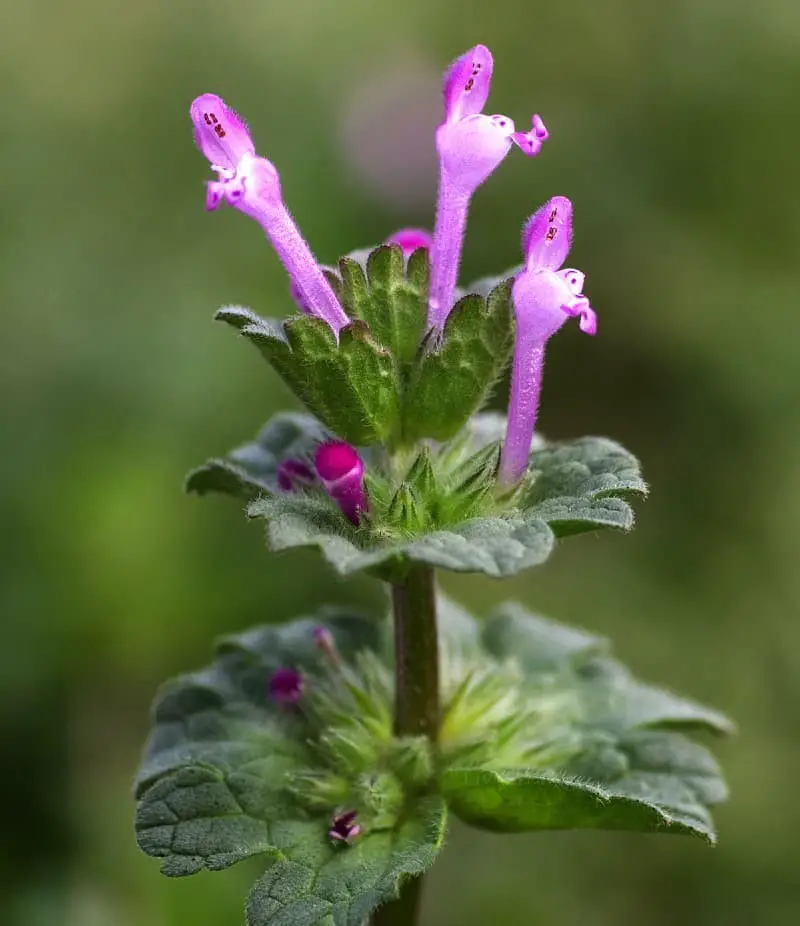
What is henbit?
Henbit, a ubiquitous winter annual, thrives across the United States as part of the mint family. Although its origins lie in Europe and Asia, this invasive species was intentionally introduced to North America during the early 19th century. Notably, henbit’s root system consists of a central taproot accompanied by an extensive network of fibrous lateral roots.
What does henbit look like?
Characterized by its distinctive morphology, the plant features an upright stem that is square in cross-section and covered in hairs. Its opposite leaves are shaped like triangles or hearts, boasting toothed margins and a soft, hairy texture. Furthermore, clusters of flowers emerge at the leaf axils, each bearing purple petals.
How to get rid of henbit:
When spring arrives, henbit can become a nuisance as it blooms and produces seeds. To effectively manage this invasive weed, it’s essential to prevent it from flowering and seeding in the first place. A simple yet effective approach is to mow or cut the plants back before they have a chance to produce flowers. This technique will not only minimize seed dispersal but also help to reduce the overall size of the plant.
For those who prefer a more chemical-based solution, herbicides can be used to control henbit growth. However, it’s highly recommended that this method is left in the hands of professionals due to potential risks and complexities involved. Alternatively, gardeners can manually remove the unwanted plants using tools like hoes or simply by pulling them out by hand. It’s crucial to dispose of the removed plants properly to prevent the spread of henbit to other areas.
Herb Robert (Geranium robertianum)
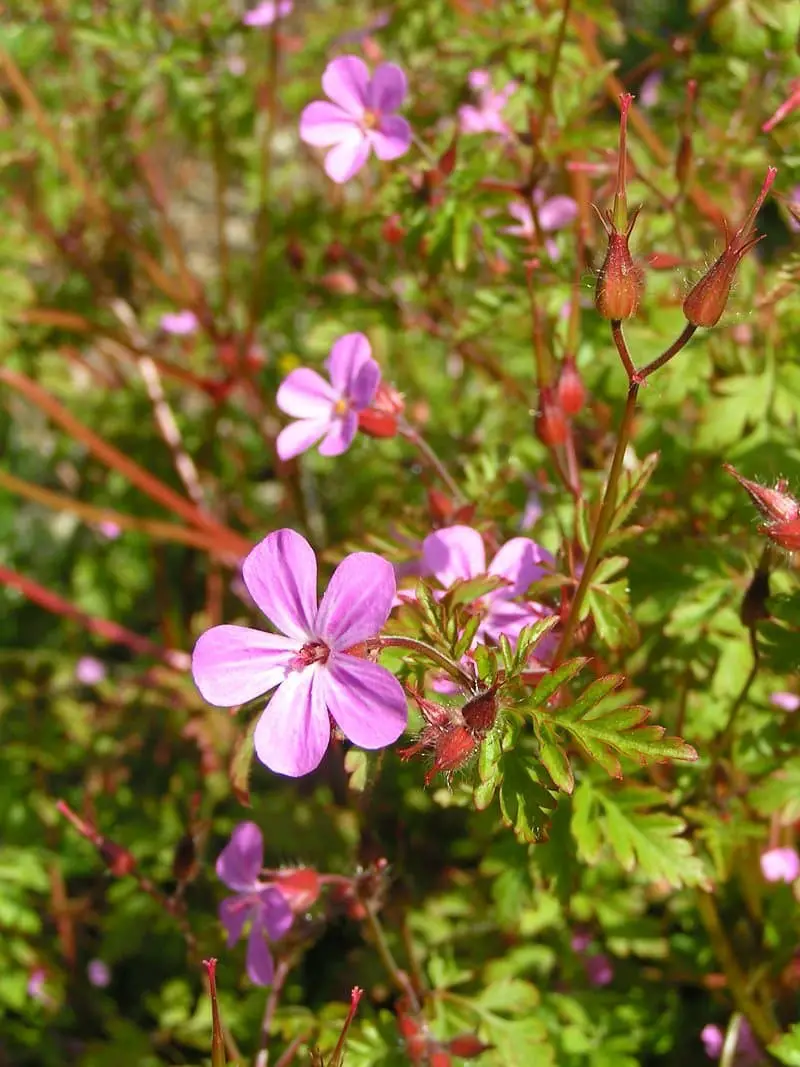
What is herb robert?
Herb Robert, a member of the geranium family, has established itself in various parts of the world, having originated from Europe and Asia. Its rich history of utilization in herbal medicine dates back to ancient times. The plant’s therapeutic properties are attributed to its leaves, stems, and flowers, which can be employed in a variety of ways. Fresh or dried leaves can be consumed, while the flowers can be infused into a tea.
Notably, Herb Robert is believed to possess a range of health benefits, including digestive support, anti-inflammatory properties, and immune system enhancement.
What does herb robert look like?
Despite its unassuming appearance, Herb Robert (Galeopsis spp.) is a charming yet easily overlooked addition to many gardens. Characterized by its slender, deep red to purple stems and minute, rose-pink blooms, this petite perennial may be small in stature but packs a big punch in terms of visual appeal. Closer inspection reveals deeply lobed leaves that are densely covered in fine hairs, adding an extra layer of texture and interest to the plant’s overall appearance.
How to get rid of herb robert:
For an eco-friendly approach to eliminating herb robert, consider leveraging white vinegar’s natural potency. Combine equal parts water and white vinegar in a spray bottle and apply it directly to the affected areas. Be prepared for multiple applications as the plant gradually withers away. When using this method, ensure pets and children stay at a safe distance until the solution has fully dried.
For more severe infestations, you may need to rely on a chemical herbicide like glyphosate, which can provide swift results. Nevertheless, it’s crucial to exercise caution when handling such substances, as they pose significant risks to human health and animal well-being. Always follow manufacturer guidelines and take necessary precautions to minimize exposure.
Red clover (Trifolium pratense)
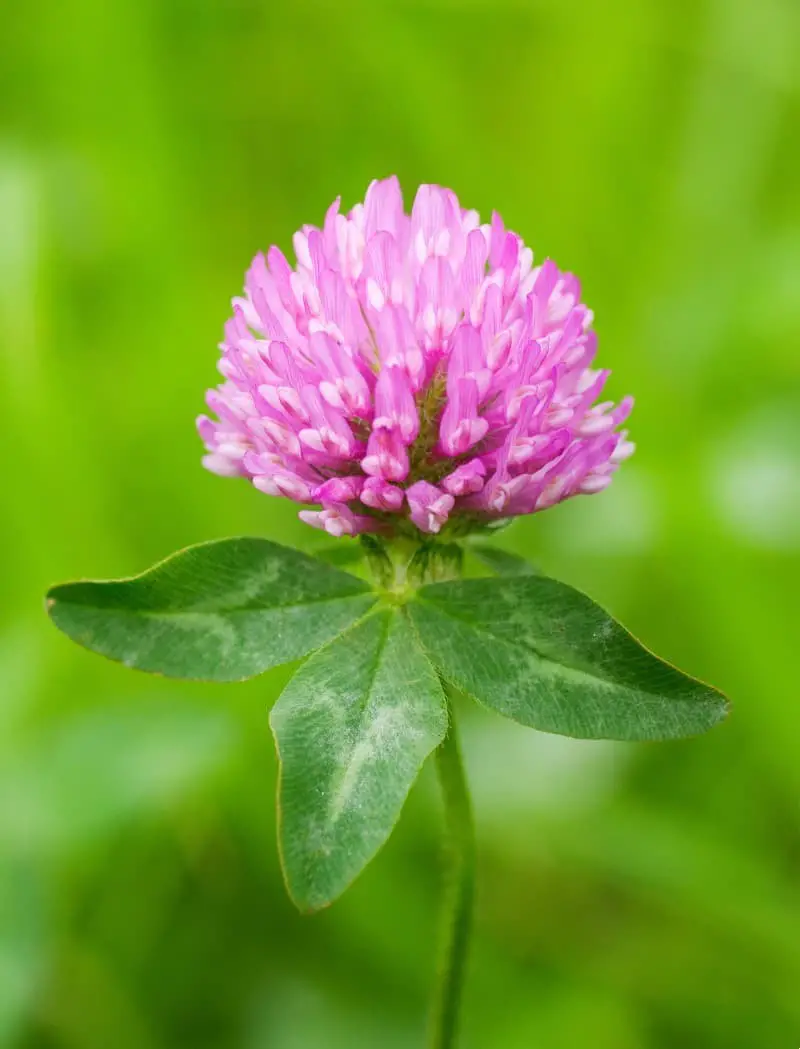
What is red clover?
Red clover, a member of the pea family Fabaceae, is an introduced species found throughout Europe, Asia, and North America, as well as on roadsides and in meadows. The hermaphrodite flowers, which bloom with vibrant red hues, rely on bees for pollination. Following successful pollination, the plant produces small, dry, dark brown seeds that disperse through wind or animal activity.
Notably, red clover can thrive in a range of soil conditions and prefers those rich in nitrogen, while tolerating partial shade if full sun is not available. Its adaptability has enabled it to establish itself in various environments, making it a common sight throughout its distribution.
What does red clover look like?
Red clover’s leaves are characterized by their trifoliate structure, featuring three leaflets with serrated edges. The leaves are arranged alternately along the stem and display a striking contrast between their dark green topsides and lighter green undersides. Meanwhile, the stems themselves are hollow and can be found in either a vibrant red or muted green hue.
The flowers of red clover are petite, pink, and clustered together in groups of 20-60 blooms.
This short-lived perennial plant is known to bloom from May to September, offering a visually appealing display of color during its relatively brief flowering period.
How to get rid of red clover:
To effectively eliminate red clover, consider two primary methods: physical removal and chemical control. For physical removal, mowing the area before the plant goes to seed is an effective approach. This method requires some effort, as you’ll need to ensure that all the vegetation is removed to prevent regrowth. Alternatively, you can attempt to dig up the red clover, taking care to extract every last root system fragment.
Failure to do so will result in the plant growing back from even a small remaining root piece. Chemical control offers another option for managing red clover. Glyphosate-based herbicides, such as Roundup, are effective at killing this invasive species when applied according to product label instructions.
Rosebay Willowherb (Epilobium angustifolium)
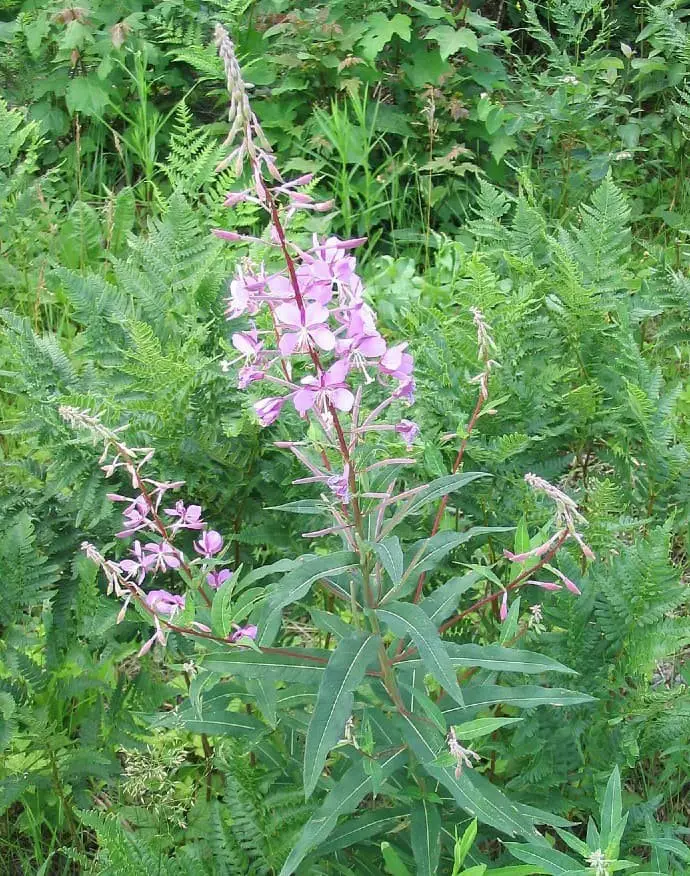
What is rosebay willowherb?
Rosebay willowherb (Epilobium angustifolium) belongs to the Onagraceae family, a group that also encompasses evening primrose and fuchsia. This perennial herb can reach impressive heights of up to two meters tall, its slender stems adorned with pink or white flowers that burst into bloom from June to September. The plant’s leaves are characterized by their narrow, lance-shaped profile, while the hairy stem adds texture to its overall appearance.
Where does rosebay willowherb grow?
Rosebay willowherb, a plant native to Europe and Asia, has successfully established itself in new territories like North America and New Zealand through human introduction. Its adaptable nature allows it to thrive in open environments, including fields, roadsides, and railway embankments, where it often forms dense clusters.
What does rosebay willowherb look like?
Standing at a height of up to two meters, this perennial herb thrives in environments with proximity to water sources. Its slender leaves, arranged in an opposite pattern along the stem, provide a striking visual contrast. The delicate pinkish-white flowers, which begin to bloom in late summer, add a touch of elegance to its overall appearance.
How to get rid of rosebay willowherb:
For a guaranteed and efficient way to eliminate rosebay willowherb, cutting and burning proves to be an unbeatable combination. However, it’s crucial to maintain regular maintenance, as even minute fragments of root can regenerate into a new growth. Furthermore, this invasive weed exhibits remarkable resilience to herbicides, making products like Roundup largely ineffective in combating its spread.
Timing is everything; the ideal moment for treatment is during late summer when the plant is in full bloom, allowing you to target the most vulnerable stage of its life cycle.
Selfheal (Prunella vulgaris)
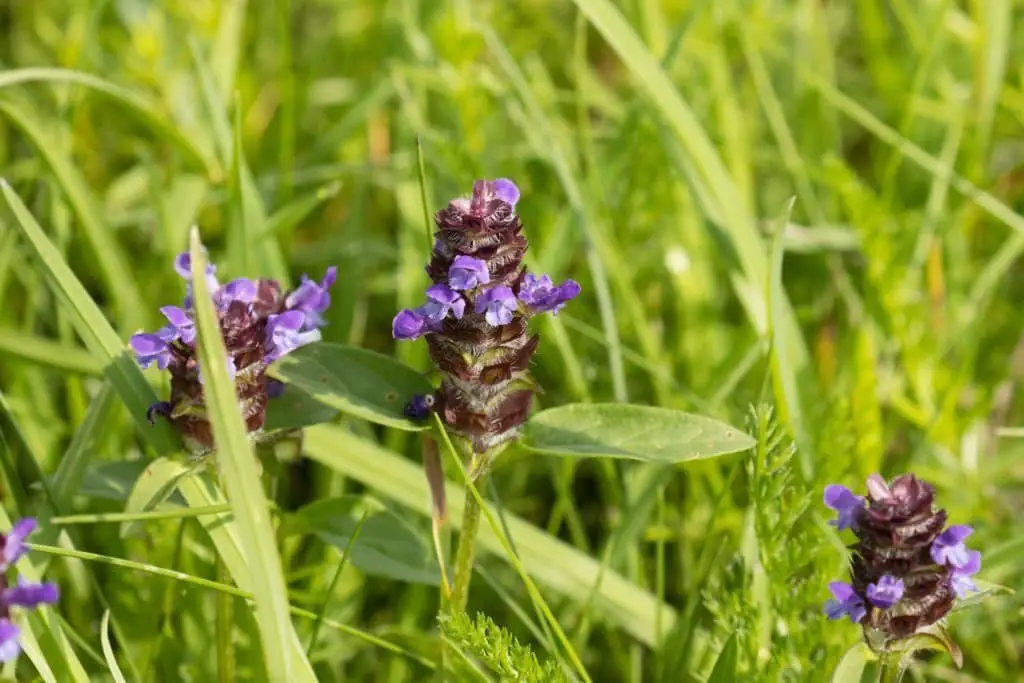
What is selfheal?
With a rich heritage in traditional medicine, selfheal has been a stalwart natural remedy for centuries. The leaves and flowers of this remarkable plant are carefully harvested to craft soothing teas and infusions, renowned for their multifaceted health benefits. Also known as Prunella vulgaris, selfheal’s versatility has earned it a special place in the annals of botanical medicine.
What does selfheal look like?
The distinctive features of selfheal include a square stem that supports opposite, lance-shaped leaves. A closer look at the flowers reveals two-lipped petals, typically presented in shades of lavender or purple. These blooms cluster tightly at the tips of the stems, forming an impressive display. Each flower is adorned with four stamens protruding from its center.
In terms of habitat, selfheal can be found thriving in a variety of environments across the United States, including woods, fields, and roadsides.
How can selfheal be used?
The versatility of selfheal is truly remarkable, as every part of the plant is edible and has been utilized for centuries in traditional medicine. The leaves can be consumed raw in salads or cooked like spinach, while the flowers add a touch of elegance to any salad. Furthermore, selfheal can be brewed into teas or extracted into tinctures for medicinal purposes. Its therapeutic applications are numerous and varied.
For instance, selfheal is often employed to alleviate digestive issues such as stomachaches, indigestion, and diarrhea. Additionally, it has been traditionally used to accelerate the healing process of wounds and burns. Moreover, its soothing properties make it an effective remedy for reducing inflammation. Selfheal’s uses extend beyond this, as it has also been historically utilized to treat respiratory conditions like bronchitis and coughs.
How to get rid of selfheal:
To effectively eliminate selfheal from your garden or lawn, it’s essential to target its root system. Start by carefully digging up the plant, taking care to remove as much of the root network as possible. Once removed, place the entire plant in a sturdy plastic bag and dispose of it properly through your trash or recycling facilities. If you’re dealing with selfheal invading your lawn, a targeted herbicide application can be an effective solution for controlling its spread.
Spear Thistle (Cirsium vulgare)
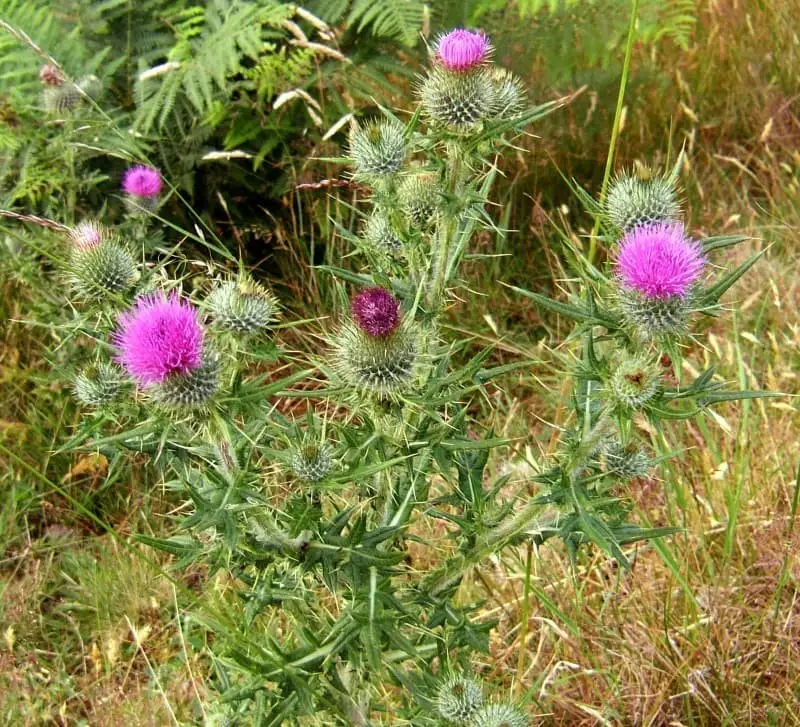
What is spear thistle?
Spear thistle (Cirsium vulgare) is a perennial herb belonging to the daisy family Asteraceae, boasting a robust presence across Europe and Asia, as well as being introduced to North America, Australia, and New Zealand. This invasive species exhibits distinct characteristics – its stems can grow up to two meters tall, branched with spiny leaves, making it a notable sight in many ecosystems.
The vibrant flowers, which come in shades of pink, purple, or white, bloom from July to September, adding a pop of color to the landscape. However, spear thistle’s invasive nature sees it spreading rapidly through seed dispersal, often forming dense stands that outcompete native vegetation, rendering it a notable concern for conservation efforts.
How to get rid of spear thistle:
When dealing with spear thistle on your property, there are several effective methods to eradicate it. One approach is to repeatedly mow the plants down throughout the growing season, which will gradually weaken and ultimately kill them. Another option is to manually dig up as much of the root system as possible, taking care to remove all the roots to prevent regrowth.
For a more targeted solution, you can use glyphosate-based herbicides, which will efficiently eliminate the weed, but be cautious when applying as it may harm other plants nearby. On a separate note, weeds with pink flowers not only add visual appeal but also provide benefits for your garden by attracting pollinators and enhancing plant health. To integrate these beneficial species into your landscape, research each type beforehand to ensure they won’t become invasive.
With proper care and planning, you can create a haven for bees, butterflies, and other pollinators, ultimately enriching the overall ecosystem of your garden.
Related Posts
When it comes to lawn care, tipping lawn service workers is a common practice that can spark debate. While some argue that tipping is unnecessary, others believe it’s a thoughtful gesture to show appreciation for a job well done. As the lawn care industry continues to evolve, understanding gratuity etiquette becomes increasingly important. In this context, one must consider the significance of overseeding your lawn, which can have a profound impact on its overall health and appearance.
The process of growing grass seeds from scratch can be daunting, but with the right guidance, anyone can become a seasoned pro. Meanwhile, creeping thyme lawns offer an attractive alternative for those seeking a unique aesthetic. In this context, weighing the pros and cons of planting and maintaining such a lawn is crucial.

